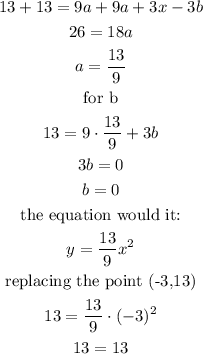ANSWER:
![\begin{gathered} y=\sqrt[]{178-x^2} \\ or \\ y=(13)/(9)x^2 \end{gathered}](https://img.qammunity.org/2023/formulas/mathematics/college/itnie7reefpmxv9wispcxb5htyrrl4czmo.png)
Explanation:
In the case that (-3, 13) is a point (x, y), the answer is the following:
The way to solve this problem is through trial and error.
In this case, we can propose the following quadratic equation:

We check the equation by replacing in the function:
![\begin{gathered} y=\sqrt[]{178-(-3)^2} \\ y=\sqrt[]{178-9} \\ y=\sqrt[]{169} \\ y=\pm13 \end{gathered}](https://img.qammunity.org/2023/formulas/mathematics/college/rm827l69l8ujiobfrdfzs7d1ku0bpyxeae.png)
Therefore, the point (-3, 13) is part of the solution of the proposed function
Or we can opt for the 3-point method:
For (0, 0) we have
0 = C
For (3, 13) we have
13 = 9a + 3b
For (-3, 13) we have
13 = 9a - 3b
adding them:
